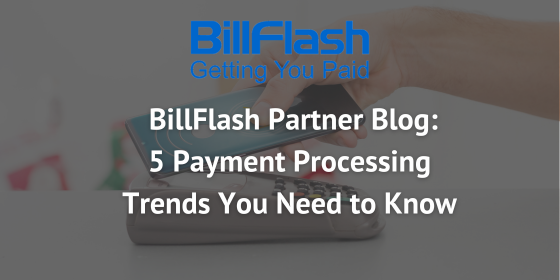Getting paid quickly and efficiently is critical for medical practices to maintain smooth operations and financial health. However, with constantly evolving regulations, technologies, and patient expectations, keeping up with the latest payment processing trends can be a challenge. Outdated systems can lead to denied claims and frustrated patients.
Improvement is critical. That is why we are sharing five key payment processing trends that medical practices should understand in 2023. Grasping these trends will position your practice to optimize payment processing — you’ll be on your way to improving cash flow, lowering costs, as well as delivering financial care patients appreciate.
Trend 1: Leveraging Digital Notifications for Payment Reminders
Communicating with patients through digital channels like SMS text messaging and patient portals has become standard across healthcare. Patients increasingly expect to receive billing notifications and payment reminders via automated text messages or emails.
In a survey, 59% of patients indicated they would rather receive a text notification than a phone call or email for billing reminders. Also, 51% of patients responded that receiving a text message about an outstanding balance would encourage them to pay their medical bills faster.
Medical practices that transition to modern, convenient communication channels for payment reminders demonstrate to patients that their practice embraces advanced technology and values patient engagement.
Implementing automated digital payment reminders provides several benefits:
- Patients find texts and emails more convenient than phone or mail — and they work!
- Automated reminders free up staff from several hours spent on manual calls and letters.
- Gently reminding patients of balances also drives better follow-through on owed payments.
- Customized processes help send reminders at just the right times.
Transitioning to modern communication channels for payment reminders also demonstrates to patients that the practice:
- Embraces cutting-edge technology to optimize operations.
- Is on a journey to building meaningful patient relationships that go beyond the practice walls.
- Values convenience and the patient’s financial experience.
Trend 2: Patient-Friendly Payment Plans and Financing Options
As healthcare costs and insurance plan deductibles continue to rise, patients face greater financial responsibility for their medical bills. Many struggle to pay large, unexpected expenses in one payment. This also heightens the need for medical practices to offer flexible payment solutions. Practices that only ask for single, lump-sum payments risk patient frustration and potential revenue loss.
In fact, recent studies show that patients value having options like payment plans that allow them to spread costs over time. Providing customized payment arrangements demonstrates financial empathy. A study from PYMNTS examined how patients are using payment plans to manage healthcare costs. The study revealed that close to 10% of patients have set up payment plans for their most recent doctor’s visits. The survey also discovered that payment plans are much more common among those living paycheck-to-paycheck (13%) compared to more financially secure patients (3%).
Those living paycheck-to-paycheck are most likely to experience financial distress due to unaffordable medical costs, and over half of patients paying with plans had faced an unexpected medical bill. Offering patient-friendly payment and financing solutions increases satisfaction and retention. When patients are presented with payment plans and financing options, they feel financially cared for and are more likely to pay when shown convenient options that align more with their budget. This also demonstrates the practice values the patient experience beyond clinical visits.
Key benefits of payment plans and medical financing include:
- Helping patients cover big, surprise medical bills without breaking the bank.
- Making it easier for patients to pay what they owe.
- Reducing the number of patients who put off care because they can’t afford it today.
- Allowing expenses to be paid over time without impacting practice revenue.
Offering flexible financial options shows patients the practice:
- Cares about helping them manage healthcare costs.
- Understands the realities they face regarding medical bills.
- Will work with each patient on payments that fit their budget.
Trend 3: Integration of Online Payment Portals
In today’s digital era, patients expect the convenience of seamless online experiences. This includes having self-service payment options through patient portals as well as other secure web platforms. Integrating online payment portals allows patients to easily view balances, download invoices, and make payments on demand. These payment processing trends can simplify and automate payment processing procedures for office staff as well. However, one-third of patients are less than satisfied with their providers’ current digital financial processes for activities like online bill payment.
Many patients would even consider switching practices after having disappointing interactions with digital billing tools and platforms. Providing patient-friendly online payment systems show a commitment to convenience and innovation. This aligns with a patient’s expectations for digital interactions. In fact, patients can take greater ownership over their financial obligations when they are empowered with transparent, user-friendly tools.
Key benefits of integrated online payment portals include:
- Patients can securely pay bills anytime, anywhere at their convenience.
- Automated reminders and tracking features reduce missed payments.
- Office staff will also spend less time on manual payment collection tasks.
- Transparent invoice views and payment histories will lead to better cost management.
Offering digital payment experiences shows that the practice is:
- Investing in technologies to create intuitive, user-friendly experiences.
- Meeting growing patient expectations for self-service financial interactions.
- Focused on making billing and payments easy for office staff and patients.
Trend 4: Streamlining Revenue with Pre-Visit Billing
Medical practices have traditionally billed patients for services after their appointment. But more and more practices are switching to upfront billing before visits. This means collecting patient payment info and confirming insurance coverage details before scheduled appointments.
Pre-visit billing is one of the most important payment processing trends that allows practices to collect copays and estimated out-of-pocket fees earlier in the process. Patients also appreciate knowing what they’ll owe ahead of time. Not only can upfront billing reduce payment delays, but it can also lower denial rates by catching coverage issues sooner. This improves cash flow and reduces unpaid balances.
As patients shoulder more healthcare costs, upfront payment collection is critical. Pre-visit billing also shows you understand the financial stress patients face. This proactive approach aligns with trends toward price transparency and financial planning.
Key benefits of pre-visit billing for practices include:
- Faster payment collection and improved cash flow.
- A reduction in claim rejections and denial-related follow-up.
- Increased ability for patients to confirm and meet obligations.
Transitioning to pre-visit billing models reflects values like:
- Proactively addressing the overall patient financial experience.
- Leveraging automation to streamline revenue cycle management.
- Using innovative processes to collect payments faster.
Trend 5: Compliance and Security in Payment Handling
As payment processing trends become more digital, protecting patient data is paramount. Practices must ensure payment activities comply with HIPAA as well as other privacy regulations. Using outdated or improper methods can put patient information at risk.
Processing payments securely requires checks like:
- Multi-factor authentication for access to financial systems. This adds a layer outside of just passwords.
- Encryption to make patient data unreadable during transactions.
- Reviewing third-party providers to ensure compliant data practices.
Regular audits help confirm controls are working and identify any vulnerabilities. Following security best practices also demonstrates the practice prioritizes patients’ trust and safety. In fact, patients are ultimately more loyal to providers they believe protect their personal information from threats.
Robust payment security measures show the practice:
- Takes transparency and HIPAA compliance to heart when handling patient payment data.
- Regularly evaluates data practices to meet the highest standards.
- Values protecting patients first — not shortcuts for convenience or cost.
Looking Ahead with BillFlash & EZClaimPay
The payment processing landscape continues to evolve and practices must adapt to these payment processing trends to optimize their patients’ financial experiences.
We’ve partnered with BillFlash to offer BillFlash Pay powered by EZClaimPay—the integrated solution that helps practices respond to these payment processing trends with features designed to provide exceptional financial experiences for your patients—and staff. Our customized payment technologies enable you to:
- Implement convenient online payment portals patients can use anytime to view their balances and make payments.
- Accept payments at your front desk without an additional EZClaim license.
- Offer flexible payment plans alleviating financial burdens.
Our patient-centered solutions also allow your team to focus on providing great medical care, while we handle the payment process and provide an exceptional payer experience that patients value. We’re here to guide you in strengthening patient loyalty and satisfaction through financial interactions your patients can depend on.
Unlock the power of BillFlash Pay powered by EZClaimPay for your practice…schedule a demo today!





